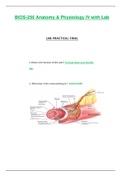Bios256 bios 256 Studienführer, Klassennotizen & Zusammenfassungen
Suchst du nach den besten Studienführern, Studiennotizen und Zusammenfassungen über Bios256 bios 256? Auf dieser Seite findest du 224 Studienunterlagen zu Bios256 bios 256.
Seite 4 aus 224 Ergebnisse
Sortieren nach
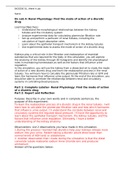
-
BIOS 256 Week 4 OL Lab 4; Renal Physiology; Find the mode of action of a diuretic drug
- Andere • 3 Seiten • 2022
-
Im Paket-Deal erhältlich
-
- 19,74 €
- + erfahre mehr
Learning Objectives: • Understand the morphological relationships between the kidneytubules and the circulatorysystem • Analyze experimental data for calculating glomerular filtrationrate • Set up and perform a perfusion of renal tubules, including thecalculation of liquid absorptionrates • Learn about the epithelial transport mechanism in the kidneytubules • Use experimental data to assess the mode of action of a diureticdrug Kidneys play a critical role in the filtration and ...
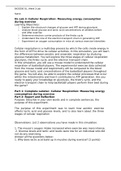
-
BIOS 256 Week 3 OL Lab 3; Cellular Respiration; Measuring energy consumption during exercise
- Andere • 3 Seiten • 2022
-
Im Paket-Deal erhältlich
-
- 19,74 €
- + erfahre mehr
Learning Objectives: • Explain the structural changes of glucose and ATP duringglycolysis • Analyze blood glucose and lactic acid concentrations of athletes beforeand after exercise • Determine electron carrier products of the Krebscycle • Understand the role of the electron transport chain in generatingATP • Experiment on oxygen consumption in mice at various exerciseintensities Cellular respiration is a multistep process by which the cells create energy in the form of ATP to ...
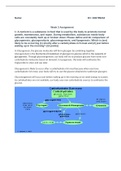
-
BIOS 256 Week 3 Discussion
- Andere • 2 Seiten • 2022
-
Im Paket-Deal erhältlich
-
- 12,03 €
- + erfahre mehr
1: A nutrient is a substance in food that is used by the body to promote normal growth, maintenance, and repair. During metabolism, substances inside body cells are constantly built up or broken down. Please define and do comparison of glycogenesis, glycogenolysis, gluconeogenesis, and lipogenesis. Which is (are) likely to be occurring (1) shortly after a carbohydrate-rich meal and (2) just before waking up in the morning? (15 points) 2: Which lipoproteins particles contain good and bad chole...

-
BIOS 256 Week 5 Discussion
- Andere • 2 Seiten • 2022
-
Im Paket-Deal erhältlich
-
- 12,03 €
- + erfahre mehr
Explain what is meant by the terms fluid balance, electrolyte balance, and acid-base balance, anddiscuss their importance for homeostasis. List the most frequent threats to acid-base balance andexplain how the body responds when the pH of body fluids varies outside normal limits.
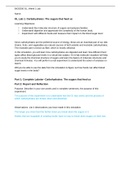
-
BIOS 256 Week 1 OL Lab 1; Carbohydrates The sugars that feed us
- Andere • 3 Seiten • 2022
-
Im Paket-Deal erhältlich
-
- 19,74 €
- + erfahre mehr
OL Lab 1: Carbohydrates: The sugars that feed us Learning Objectives: • Understand the molecular structure of sugars andpolysaccharides • Understand digestion and appreciate the complexity of the humanbody • Experiment with different foods and measure their impact on the blood sugarlevel Since carbohydrates are the preferred source of energy, these are an essential part of our diet. Grains, fruits, and vegetables are natural sources of both soluble and insoluble carbohydrates. The...
LAB PRACTICAL FINAL

-
BIOS 256 Week 1 Discussion; The Digestive System - Liver
- Andere • 2 Seiten • 2022
-
Im Paket-Deal erhältlich
-
- 12,03 €
- + erfahre mehr
The digestive system is composed of two parts: the alimentary canal and the accessory digestive structures. These two parts of the system work together to break down food into absorbable units and eliminate the non-digested material as feces. Let's begin by identifying each of the organs in the alimentary canal and the accessory digestive structures.

-
BIOS 256 Week 6 Discussion; male and female reproductive systems
- Andere • 2 Seiten • 2022
-
Im Paket-Deal erhältlich
-
- 12,03 €
- + erfahre mehr
What are the major differences and similarities between the male and female reproductive systems? Which structures are homologous vs which structures are derived from the same embryonic tissues?

-
BIOS 256 Week 1 Discussion; The Digestive System - Pancreas
- Andere • 2 Seiten • 2022
-
Im Paket-Deal erhältlich
-
- 12,03 €
- + erfahre mehr
The digestive system is composed of two parts: the alimentary canal and the accessory digestive structures. These two parts of the system work together to break down food into absorbable units and eliminate the non-digested material as feces. Let's begin by identifying each of the organs in the alimentary canal and the accessory digestive structures.
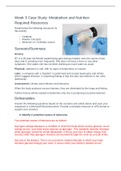
-
BIOS 256 Week 3 Case Study; Metabolism and Nutrition
- Andere • 2 Seiten • 2022
-
Im Paket-Deal erhältlich
-
- 19,74 €
- + erfahre mehr
Required Resources Read/review the following resources for this activity: • Textbook • WeeklyConcepts • Minimum of 1 scholarlysource Scenario/Summary History: BT is a 36-year-old female experiencing pain during urination over the course of two days and is urinating more frequently. She does not have a fever or any other symptoms. She states she has not been drinking as much water as usual. Physical: abdomen is soft, with no signs of tenderness or masses Labs: a urinalysis with...

5,99 € für deine Lehrbuchzusammenfassung mal 100 Kommilitonen... Rechne mal nach: Das ist eine Menge Geld! Warte nicht länger, sondern fang jetzt an, deine Zusammenfassungen hochzuladen. Entdecke alles über Verdienstmöglichkeiten auf Stuvia



